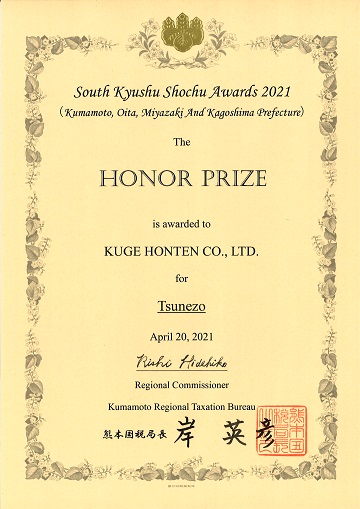It’s the Final Curtain for the Bungo Barley Shochu Group (July 12, 2022)

In the morning edition of the Oita Godo Shimbun (local newspaper), it was announced that the Bungo Bakuchudan had held its 60th and final event.
Kubo Sake Brewery (Usa City) and Kuge Honten were honoured to participate in the final get-together, again being given the opportunity to deepen the relationship with our customers.
It was initially set up back in 2010 with the goal of raising awareness about Oita-made shochu.
First, I would like to thank Mr. Tsuda from Tashibunosho (Bungotakada City), who arranged the events, Mr. Shiotsuki from Liquor Mart Shiotsuki (Saiki City), and Mr. Maruta from Maruta Sake Store (Oita City). But above all, I would like to express my sincere gratitude to everyone who has participated in the event and supported Oita’s shochu. We look forward to your continued support for Oita-made alcohol.
Our Shochu - Tsunezo came in First Place (April 19, 2022)
 |
 |

Our barley and potato shochu - Tsunezo both won first prize at the 2022 Kumamoto Regional Taxation Bureau’s Liquor Appraisal Meeting.
We use Toyonohoshi barley from Oita Prefecture and Beniharuka (Kanta-kun) potatoes from Usuki City, Oita Prefecture. In addition, the yeast used in both the barley and potato shochu is also from Oita.
Thanks to local sourcing, these products are really connected to our region.
Oita Yeast (August 25, 2021)
 |
 |
We are currently in the middle of the production process for our barley shochu - Tsunezo. For this, we use Oita Prefecture’s original barley variety, Toyonohoshi barley. The yeast we use is also Oita Yeast, produced here in Oita Prefecture.
Oita Yeast was developed by the Oita Industrial Research Institute using the prefecture’s kabosu juice as a separation source.
In the brewing test, the Oita Yeast evaluation stated that the alcohol yield, flavour, and liquor quality were comparable to those of the Association Yeast and Kagoshima Yeast. In addition, it was said that it’s a great combination with our local Toyonohoshi barley.
Our barley shochu - Tsunezo and sweet potato shochu - Tsunezo, produced using Oita Yeast, won the Honour Award at the Kumamoto National Taxation Bureau’s Liquor Appraisal in the third year of Reiwa (2021).
The fact that our barley shochu - Tsunezo is produced using the Oita double-barrel (Toyonohoshi barley and Oita Yeast) means that it’s no surprise that it goes well with locally grown kabosu, especially when you think about the yeast’s source.
The picture shows our section chief, Mr. Murakami (right), preparing the Oita Yeast and Toyonohoshi barley for the koji.
The Production of Barley Shochu has Begun (July 2, 2021)
 |
-360.jpg) |
We have started our barley shochu production. We’re also looking forward to producing our delicious shochu this year.
*Section Chief, Mr. Murakami, is carefully monitoring the barley steaming process. We are using Oita’s original shochu barley, Toyonohoshi.
Bakushu - It’s Time to Harvest the Barley (May 27, 2021)
 |
 |
Bakushu: When the barley spikes have fully grown, normally around early summer, we know that harvest time is here.
We visited a farm in Chitose, a village in Bungoono City, to see the fruits of this year’s harvest of Toyonohoshi, a new variety of barley being cultivated right here in Oita Prefecture, that is great for producing fantastic shochu.
We use Toyonohoshi in our barley shochu, Tsunezo and Tsunezo Breeze.
Our Tsunezo Shochu Wins an Honour Award (April 20, 2021)
 |
 |
 |
 |
At the 2021 Kumamoto Regional Taxation Bureau - Liquor Appraisal Meeting our barley and sweet potato shochu, Tsunezo, received the Honour Award.
We will strive to continue improving our methods with the goal of delivering high quality alcohol to our customers.
The Oita Prefecture Honkaku Shochu Kikizake - Sake Tasting Meeting (January 27, 2021)
 |
 |
The Oita Prefecture Honkaku Shochu Kikizake - Sake Tasting Meeting was held in 2020, hosted by the Oita Prefectural Sake Brewer Association. Ms. Iwata (appraiser, general manager) and Ms. Iehara (appraiser) from the Kumamoto Regional Taxation Bureau were both in attendance.
We at Kuge Honten exhibited our barley and sweet potato shochu. Both received high evaluations. We will now take on board the guidance we received and plan to exhibit at the Kumamoto Regional Taxation Bureau - Liquor Appraisal Meeting with the goal of winning a prize!
Barley Shochu Distillation - Vacuum Distillation (November 13, 2020)
After 12 days of fermentation the secondary mash, which has an alcohol content of 17% vol, is sent to the distiller for distillation (vacuum distillation).
Following the distillation, the barley shochu’s alcohol content has increased to 44% vol.
Vacuum distillation gives the shochu a milder clean taste. This clear light flavour is the result of the reduced-pressure distillation, achieved by using a vacuum pump.
Barley Shochu - Secondary (Main) Mash “Moromi” (November 12, 2020)
During the secondary or main mash, steamed barley and water are added to the primary mash. The steamed barley is added using an “air-shooter”, a kind of air-pump, that distributes the barley evenly into the mash.
The steamed barley starch is converted into glucose using enzymes in a process called saccharification. This is then quickly fermented using yeast which turns the glucose into alcohol.
We use a “parallel double fermentation” method to produce the alcohol. This means we perform the saccharification and fermentation in parallel - at the same time.
Barley Shochu - Primary Mash “Moromi” (November 11, 2020)
Today we moved the barley koji (prepared yesterday) from the shelf to the tank in preparation for the primary mash.
The primary mash consists of koji, water and yeast, and is fermented for 3 to 8 days.
The importance of this mash is paramount as it will directly affect the fermentation of the secondary mash.
We use barley koji for barley shochu whereas rice koji is mainly used in other kinds of alcohol.



 日本語
日本語